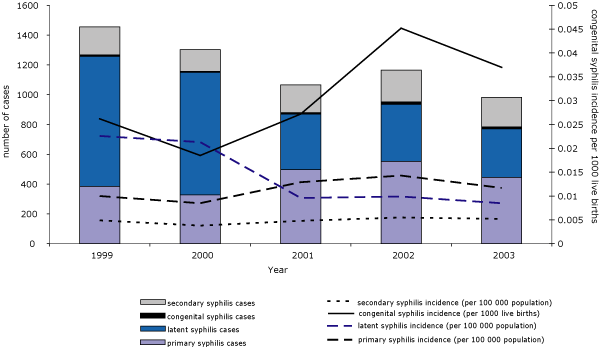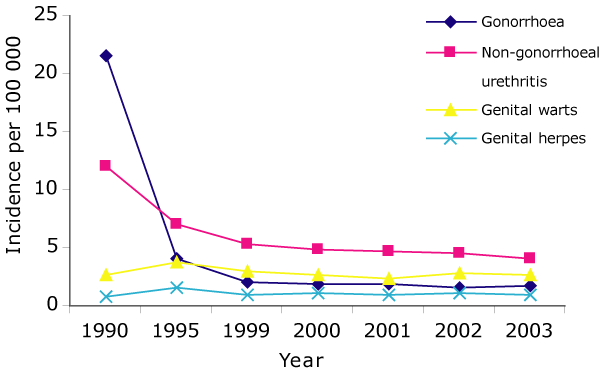|
Public health surveillance of sexually transmitted infections (STIs) began in Poland in 1946, in response to an epidemic of syphilis and gonorrhoea that occurred after the second world war [1]. The system established included reporting and registration of cases, partner notification and treatment, and the screening of pregnant women for syphilis. This system existed until 2001, when the new Infectious Diseases and Infections law was passed [2]. The new list of notifiable STIs includes syphilis, gonorrhoea, non-gonoccoccal urethritis, genital herpes, genital warts, and HIV. HIV surveillance is carried out separately by the Panstwowy Zaklad Higeny (National Institute of Hygiene). National STI surveillance in Poland relies on both laboratory and physician reporting (Table 1). Local dermato-venereological clinics report data to the regional Register of Venereal Diseases, which sends annual aggregated reports to the Instytut Wenerologii (Institute of Venereology) in Warsaw. The Institute monitors the national epidemiological situation and publishes an annual analysis of trends. Table 1. General information on STI surveillance system in Poland Public health surveillance includes:
Results In 2003, congenital syphilis was diagnosed in 13 children aged 1 to 12 years. The congenital syphilis rate per 1000 live births peaked in 2002 (0.0452 per 1000 live births), and in 2003, this rate was still high (Figure 1). This fall in recorded syphilis should be seen in the context of a decline in testing. In 2003, 941 932 blood samples were tested for syphilis by the network of venereology laboratories. This number for 2003 was 19% less than in 2002, about 65% lower than the number of tests in performed in 1999, and 89% less than the number of tests done in 1990 (Table 4). The index of immediate treatment of contact persons to cases increased from 0.19 in 2002 to 0.27 in 2003. This index is calculated as the ratio of the number of individuals treated by prophylaxis to the number of all primary syphilis cases. Figure 1. Distribution of reported syphilis cases and syphilis incidence by stage of infection, Poland 1999 – 2003.
Table 3. Incidence of congenital syphilis and syphilis diagnosed in pregnancy and childbirth
Other STIs The registered incidence of other STIs decreased in 2003. The incidence of non-gonococcal urethritis decreased by 13%, genital warts by 10%, and genital herpes by 27% (Figure 2). Figure 2. Sexually transmitted infections in Poland, 1990 - 2003. [4,5]
Discussion and conclusions Since diagnosis of early latent and secondary syphilis cases relies on laboratory investigations, these cases may be underdiagnosed. Unsatisfactory detection of early latent syphilis is also related to the limiting of the syphilis screening program to blood donors and pregnant women. Before 2001, the screened population included all patients in hospital, those employed in the healthcare and education systems, food industry workers, first time employed and prisoners. Moreover, although every pregnant woman should be screened for syphilis twice during her pregnancy under current regulations, this is not always the case, and the rate of congenital syphilis is rising (Table 3). There is inadequate financing to maintain a functional surveillance system with appropriate laboratory screening and health promotion activities. Furthermore, effective contact tracing and notification of cases by physicians are sometimes hampered by misinterpretation of the legal regulations and fear of breaching the Data Protection Act. In addition to the unfavourable circumstances in the healthcare system, the STI epidemiological situation is affected by increasing numbers of commercial sex workers (both brothels and street prostitution) and an exceptional growth of syphilis and HIV/AIDS incidence in the bordering Newly Independent States. Treatment and testing for STI patients was government funded until 2001, and were free of charge for all patients. Since 2001, STI treatment has been financed by public healthcare insurance, which covers only employed persons and their families, the retired and pensioners, and, for a limited time, registered unemployed persons. Even people who have insurance must pay part of the medication costs. In order to control the STIs in Poland, it is now crucial that free treatment be provided for all STI patients, regardless of whether or not they are insured. If there is an STI epidemic, which could well happen in Poland and eastern European countries, costs of treatment are likely to be much higher than the costs of effective prevention. Footnote: Syphilis case definitions used in Poland Case definition for Primary Syphilis. Case definition for Secondary Syphilis Case definition for All Syphilis Case definition for Congenital Syphilis References:
Источник: Eurosurveillance weekly releases 2005 > Volume 10 / Issue 2 |

